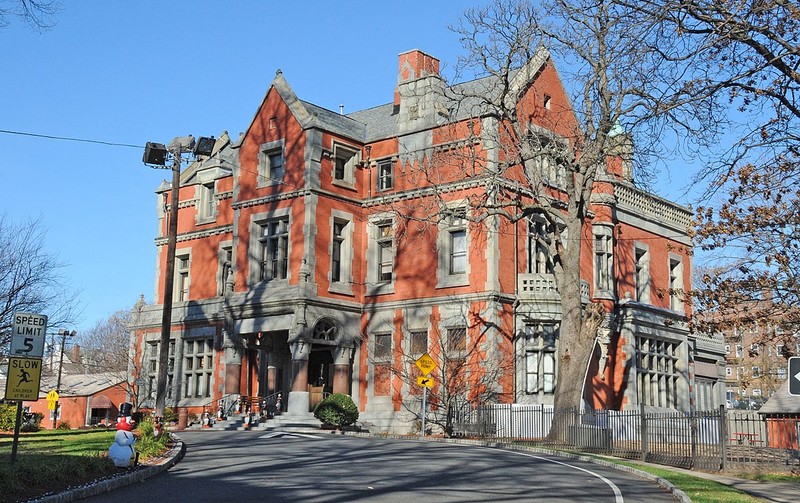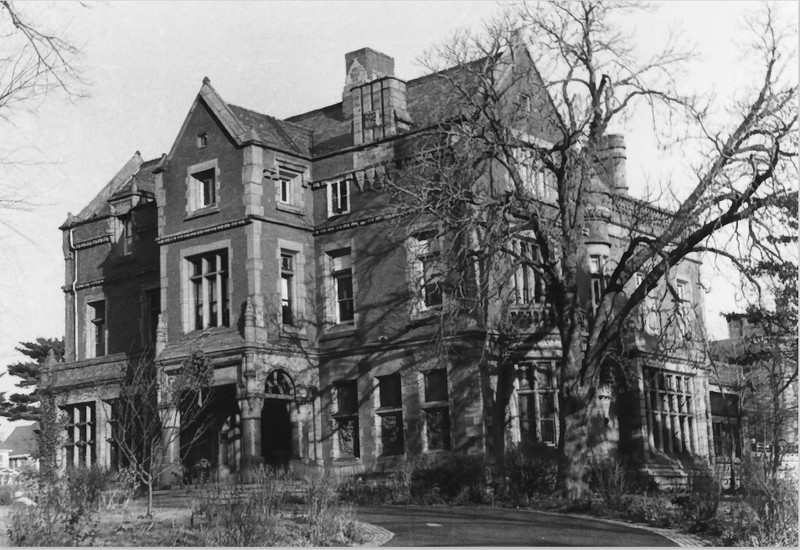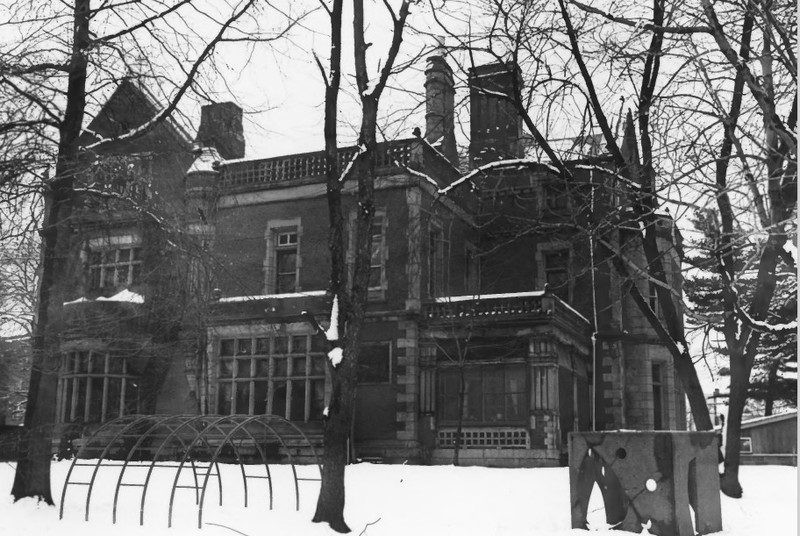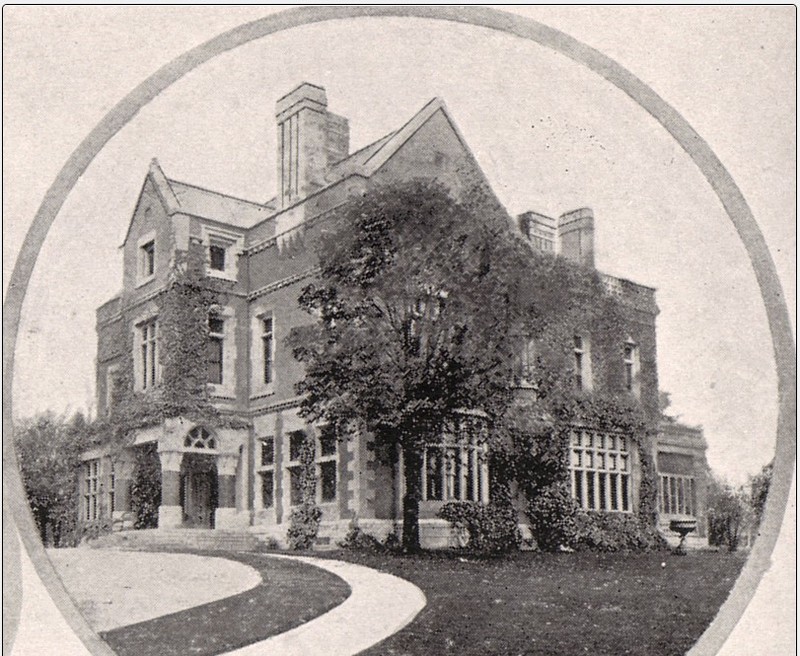William Clark House/ North Ward Center
Introduction
Text-to-speech Audio
Images
2015 photo of Wm. Clark House, part of North Ward preschool (Jerrye & Roy Klotz, M.D.)

1977 photo of front of William Clark House taken from the circular driveway (Vacca et al.)

1977 photo of rear and east facades of William Clark House (Vacca et al.)

Photo of Clark Mansion from 1905 book "Views of Newark" (L. H. Nelson Company)

Backstory and Context
Text-to-speech Audio
William Clark and his much-older brother George A. were born in Paisley, Scotland. An ancestor had discovered that thread could be made from cotton that was superior to the linen threads then in use. George A. emigrated to Canada and partnered with his brother-in-law, Peter Kerr at the Ontario firm, Kerr & Company. After Kerr's death, George became the sole owner of the cotton thread-making company. William Clark emigrated to the U.S. in 1860. George Clark established a small plant in Newark in 1864 in rented space, as the Passaic Thread Company. The large factory, Clark Thread Mills, opened in 1866 in East Newark with the new company name. George's brother, William became his business partner that year. After George died in 1873 and another brother, Alexander, died in 1877, William became the sole owner of the Clark Thread Company. William expanded operations to both sides of the Passaic River. He had his mansion built on a hill overlooking the river, with views of the Manhattan skyline.
William Clark was widowed by 1880 and was living on Mt. Pleasant Ave. The 39-year-old manufacturer of thread had a son, John W. (age 12), and daughter, Eliza B. (10), both of whom were born in New Jersey; their late mother had been born in Scotland. Isabella Parker (60), a Scotland native, may have been the widowed maternal grandmother. Three female servants completed the household. William remarried in 1882 to Jennie B., a New Jersey native two years younger than him. In 1900, the couple shared the Mt. Prospect Ave. home with their children, twins George and Margreta (age 14), two house servants, and a gardener and his family. William was a 60-year-old thread manufacturer in 1900 and a naturalized U.S. citizen. William passed away in July 1902 while on his yacht at Portland, England. Upon William's death, his nephew, William Campbell Clark (1863-1912, a son of James Clark) became President of the Clark Thread Works in Newark.
The house took years to build in a part of what had been Branch Brook Park, and cost about $200,000. Part of that sum went to the architect, William Halsey Wood, the designer of the First Baptist Peddie Memorial Church in Newark. Wood died young in 1897 and has been called the "father of Modern architecture" by the famous architect Frank Lloyd Wright. The William Clark House faces south; the main block is about 60 feet square. A rear ell on the west side is about 40 by 30 feet. The roof is gable and low-pitched hipped and pierced by several tall brick chimneys. The foundation is ashlar stone and brick and the basement is partially raised. The house's red brick walls are ornamented by stone beltcourses, quoins and a watertable. When the house was documented for the National register in 1976, most of the windows were one-over-one sash, with stone stills, lintels and quoins; there are some bay windows on the main block. The main entrance is beneath a gabled central pavilion supported by marble columns. The original floor plan and oak flooring remained, as well as elaborate plasterwork and woodwork on the main floor. The second floor of the main block held six bedrooms and associated dressing and bathrooms; the second floor of the ell held the servants' quarters. The original stone and case iron fence bounded the east side of the large lot.
Many of the rooms were being used as classrooms for the North Ward Educational and Cultural Center, Inc. (NWECC) after the organization purchased the mansion in the mid-1970s. The North Ward Center's current CEO, Michele Adubato, is the daughter of the founder, Stephen N. Adubato. A fire in the mid-1970s damaged the third floor of the house, the main stairway from the second to the third floor, and much of the roof of the main block. A non-historic building within the portion nominated to the National Register was a modern combined garage/shop/storage building.
Sources
Anonymous. "William Clark Dead; Thread Manufacturer of Newark, N.J....." New York Times (New York, NY) July 8th 1902. 9-9.
Cummings, Charles. The 'Modern' Palaces where Innocence Melded with Pretension, Knowing Newark, History and Landscape. August 20th 1998. Accessed January 21st 2021. https://knowingnewark.npl.org/the-modern-palaces-where-innocence-melded-with-pretension/.
Geisheimer, Glenn G. Clark Mansion, Old Newark, Historical Areas. January 1st 2020. Accessed January 17th 2021. https://oldnewark.com/historicalareas/homes/clark.php.
Hunnewell, Sarah Farnsworth. William Campbell Clark (1863-1912), Geni, William Campbell Clark of Ralston. September 7th 2019. Accessed January 19th 2021. https://www.geni.com/people/William-Campbell-Clark-of-Ralston/6000000024789305637.
U.S. Census. Household of William Clark on Mt. Prospect Ave., Newark District 53, N.J., Dwelling 212, Family 259. Washington, DC. U.S. Government, 1880.
U.S. Census. Household of William Clark at 346 Mt. Prospect Ave., Newark Ward 8 District 77, N.J., Dwelling 94, Family 108. Washington, DC. U.S. Government, 1900.
University of Glasgow Archives Services. Records of the Clark Thread Co, Newark, New Jersey, USA..., ArchivesHub. Accessed January 19th 2021. https://archiveshub.jisc.ac.uk/search/archives/9fcee163-7579-3a9a-8786-a9e863724f8e.
Vacca, Anthony. Eshleman, Donald L. Adams. George R. NRHP nomination of William Clark House. National Register. Washington, DC. National Park Service, 1977.
https://en.wikipedia.org/wiki/William_Clark_House_(Newark,_New_Jersey)#/media/File:WILLIAM_CLARK_HOUSE,_NEWARK,_ESSEX_NJ.jpg
https://npgallery.nps.gov/AssetDetail/NRIS/77000863
https://npgallery.nps.gov/AssetDetail/NRIS/77000863
Reproduced on website "Old Newark": http://www.oldnewark.com/photos/historical/index.php?cat=22
